Guide C-312
Revised by Nicole Lujan
College of Agricultural, Consumer and Environmental Sciences, New Mexico State University
Author: Extension Home Economist/4-H Agent, Sandoval County Extension Office, New Mexico State University. (Print Friendly PDF)
Selecting fashions that present you at your best is not difficult if you apply a few basic principles of design. But in order to apply design principles correctly, you must know your figure type. Which are you?
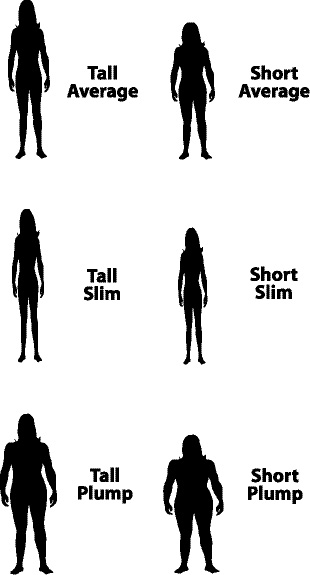
Or, perhaps both your height and body type are average. Whatever your figure type, the fashions you wear will be flattering or unflattering depending on their designs.
To help you select the designs best suited for your figure type, consider the following design principles.
Line
The wise selection of line in fashion design can create optical illusions to flatter your appearance.
Line in fashion is seen in garment details and in the garment silhouette. Details include seamlines and garment features such as pockets, collars, belts, and openings. Silhouette refers to the shape of the garment. A silhouette in fashion is dependant on the design of the garment and the fabric used. Both the detail lines and the silhouette influence the optical illusion created when a garment is worn.
Look at these examples of optical illusion:
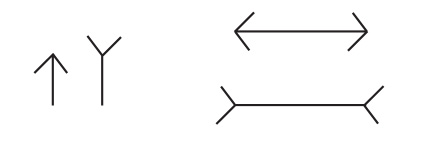
Would you believe the vertical lines are the same length? The horizontal lines are the same length also. The eye follows each line until it meets a line that turns downward or upward. The lines look shorter when lines turn downward and longer when lines continue upward.

Now, look at the rectangles. The four rectangles are the same size, but the use of a vertical or horizontal line within each rectangle creates an illusion of varied size. When two or more vertical or horizontal lines are used, the spacing between the lines will affect the illusion created.

Generally, vertical lines that carry the eye up the figure without interruption will give a taller, more slender illusion. Lines that stop the eye from traveling upward by moving the eye from side to side or back down will create a shorter and heavier illusion.
Consider these examples:
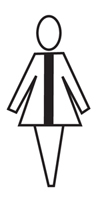 |
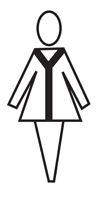 |
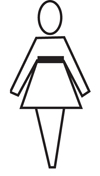 |
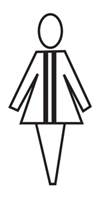 |
| The single vertical line moves the eye upward, with nothing to interrupt its movement. | The magic "Y" creates a feeling of height as the eye is guided upward, with nothing to impede its vertical motion. | The longer your eye can travel upward without being interrupted by a horizontal line, the taller the figure will appear. | Two vertical lines spaced close together form a narrow panel that moves the eye up the figure. |
 |
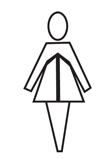 |
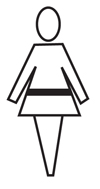 |
 |
| A vertical illusion becomes a horizontal illusion when a vertical line is topped with a horizontal line, causing the eye to move from side to side. | A vertical line suddenly appears shorter when the eye is forced downward. | The sooner the eye encounters a horizontal line, the shorter the figure will appear. | Two vertical lines spaced far apart form three wide panels that move the eye across the figure. |
Color
Color is one of the first things people notice about clothing. The use of color can create illusions of the figure size in the same way line does. Select colors based on your complexionS—hair, skin, eyes—as well as your figure size.
Colors should complement your complexion. A complexion that tends to be sallow (yellow tones) should wear colors that bring out the pink/red tones of the skin. A complexion that is florid (red/blue tones) should avoid colors that emphasize the redness of the skin.
Matching color to complexion is a very personal matter. Old adages like "redheads should never wear pink" are not always valid. Careful selection of the value and intensity of a color, its placement, and the complements used with the color can allow almost everyone to use it.
Colors are classified as warm (reds, yellows, and oranges) or cool (blues and greens). Warm colors tend to create an illusion of greater size. Cool colors tend to create an illusion of reduced size.
The brightness or dullness and the lightness or darkness of colors also affect the illusion created. Dull and dark colors seem to recede and make the figure appear smaller. Bright and light colors have the opposite effect.
In addition to these general characteristics of colors, how they are used will also influence the illusion created. Contrasting colors in tops and bottoms create a horizontal line where they meet and tend to shorten the figure. A single-color outfit gives a vertical feeling and creates an illusion of height and slimness.
When several colors are used in a single outfit, the amount, placement, and contrast between the colors used will determine the effect. If the color is printed in the fabric design, the size of the design, as well as the colors used, must be considered. Generally, the size of print should be selected in relation to your figure size: small figures look best in fabrics with small designs, while large figures look best in fabrics with large designs. These guidelines are especially true if the colors are bright and contrast strongly.
Texture
Because garments have combined design elements of texture, color, and line, each must be selected in relation to your figure and how they affect each of the other elements. The effects of texture in fashion influence how colors appear and how design lines function.
Texture describes the body and surface of fabric. Textures may be rough or smooth, coarse or fine, crisp or clingy, soft or stiff, thin or bulky, opaque or sheer, shiny or dull, heavy or light, or any combination of these characteristics. Because textures have many characteristics, they can enhance or detract from a garment's design. They also affect the illusions of size and shape of the figure.
Here are some general guidelines for selecting appropriate textures for garments:
- Soft or clingy textures reveal the figure and emphasize figure irregularities.
- Stiff or crisp textures stand away from the body and hide figure irregularities. Very stiff fabrics appear to add weight and dwarf small figures. Moderately stiff fabrics are good on most figures.
- Bulky textures seem to add volume to the figure. Small figures are overpowered by these textures, but they are good for tall, slender figures. They can be used to balance an irregular figure. Example: Bulky sweater for figure with small bust and full hips.
- Dull finishes absorb light and generally make the figure look smaller. They are suitable for all figures.
- Shiny fabrics make the figure appear larger and reveal figure irregularities. Shiny fabrics are best for average to slim figures that have regular proportions.
- Coarse or rough fabrics are good choices for average to slim figures. They add volume to large figures and overpower small figures.
- Smooth (not shiny) fabrics hide figure irregularities and are attractive on most figure types.
Tips on Selecting Fashions For You
Most women have special figure problems that they want to de-emphasize. The following suggestions are designed to help you select fashions that will generally camouflage problems and flatter your figure.
To look shorter or heavier select:
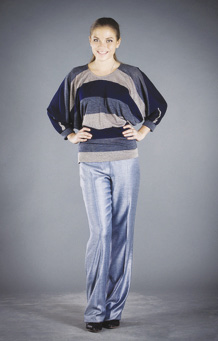
- Details extending beyond the silhouette
- Bulky, bunchy silhouette lines
- Curved rather than straight lines
- Crosswise design lines
- Horizontally striped fabrics
- Short, broken vertical lines
- Short diagonal lines
- Combinations of vertical and horizontal lines, as in a plaid fabric
- Full, horizontal drapery across the bustline or hipline
- Soft fullness
- Bloused waistline
- Flaring or contrasting cuffs and collars
- Wide, bulky collars
- Capes
- Separates, two piece effects, overblouses
- Flounces
- Yokes and insets
- Patch pockets
- Off-the-shoulder effects
- Wide belts and cummerbunds
- Dolman sleeves
- Long, full sleeves
- Wide, flowing sleeves
- Three-quarter sleeves
- Gathered, pleated, and flared skirts
- Short skirts
- Short coats
- Long jackets
- Double-breasted styles
- Peplums and tunics
To look taller or thinner select:
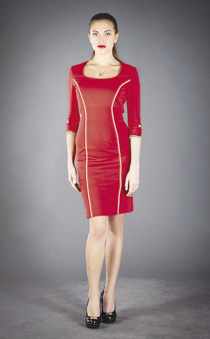
- Details within the silhouette
- Straight rather than curved lines
- Long, vertical lines, especially near center of figure
- Vertically striped fabrics
- Simple, uncluttered lines
- Long diagonal lines
- Slim, smooth silhouette lines
- Narrow panels or gores
- Narrow, standing collars
- High necklines
- Long, narrow, pointed collars
- Long, narrow V- or U-necklines
- Narrow vest openings
- Narrow belts, preferably to match garment
- Long, straight sleeves
- Raglan sleeves
- Sleeveless garments
- Decoration high on the shoulder or near the neck
- Slim skirts
- Skirts as long as possible to be fashionable
- Boleros or short jackets
- Full-length coats
- Coat with button-down-the-front style
- Princess lines and beltless one piece dresses
To make your short waist look longer select:
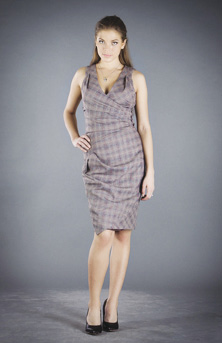
- V-necklines
- Center front closing with collarless neckline
- Narrow center panel in bodice
- Long torso lines
- Overblouses
- Short skirts (within fashion limits)
- Narrow or no belt
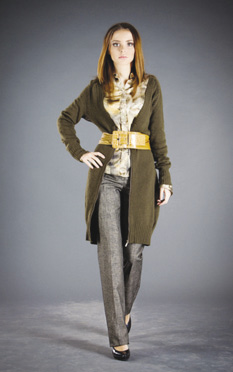
- Wide belts and cummerbunds
- Vertical lines in skirts
- Wide midriffs
- Skirts as long as possible to be fashionable
- Shoulder yokes
- Boleros and short jackets
- Raised waistlines
To conceal a flat chest select:
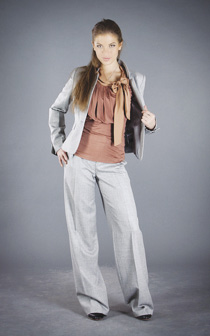
- Soft front fullness (gathers, pleats, frills)
- Large collars
- Bows at the neck
- Round, soft details, such as in collars
- Cowl necklines
- Bolero jackets
- Capes
- Pockets and pocket flaps at bustline
- Full sleeves
- Cuffs on sleeves adjacent to the bust line
To conceal a large bust select:
- Soft front fullness, either above or below the bustline
- Jabot or soft full tie at the neck line
- Softly draped bodices
- Lines to broaden shoulders
- Boxy jackets
- Full skirts
- Soft flare in skirts
- Details in skirts
To make narrow hips seem wider select:
- Wide center panel in skirts
- Hip yokes
- Pleated skirts, especially with wide pleats
- Skirts with side drape, especially at hips
- Wide or contrasting sleeve cuffs at hipline
- Side-pleated skirts
- Gathered skirts
- Circular skirts
- Large patch pockets, especially toward side of skirt
To make wide hips or large thighs seem more narrow select:
- Soft fullness or gores in skirt
- Narrow center panels (attracts eye away from silhouette)
- Widening effect at the waistline
- Shallow skirt yokes
- Loose, short jackets
- Bodice emphasis at the shoulders
To hide a swayback select:
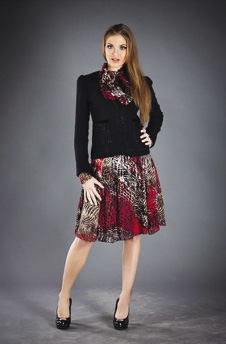
- Straight-line jackets
- Short jackets ending below the waistline
- Gathered skirts
- Belts buckled at the back
- Bloused bodices
- Capes
- Peplums
- Crushed belts or cummerbunds
- Lengthened, loose bodices
To hide a prominent abdomen select:
- Details away from the center front
- Styles without belts
- Bodices with easy gathers at the waistline
- Cord belts that tie to the side of the tummy
- Details above waistline
- Overblouses
- Dresses with a side-wrap
- Narrow, self-fabric belts
To conceal round shoulders select:
- Slightly bloused backs
- Blouse gathered at waistline
- Small collars
- Semi-fitted jackets
- Bolero jackets
- Set-in sleeves
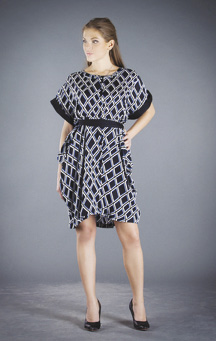
- Oval or V-necklines
- Narrow collars and lapels
- Raglan sleeves
- Kimono sleeves
- Flared peplums
- Horizontal lines in skirts
- Full skirts

- Horizontal lines at chest
- Shoulder yokes
- Wide, cape-like collars
- High pockets
- Wide lapels
- Diagonal lines to tip of shoulders
- Bateau necklines
- Narrow, deep V-necklines
- Narrow, flat, and pointed collars
- Cardigan styles
- Low necklines
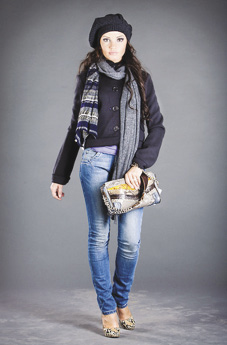
- Curved, high necklines
- Standup collars
- Soft, full, or deep collars
- Scarves and ascots
- Ruffled jabots
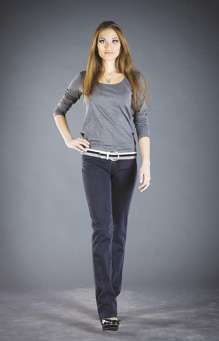
- V-necklines
- Deep, oval necklines
- Sweetheart necklines
- Soft, rounded collars
- High, square, or round necklines
- High, draped necklines
- High, round necklines
- Softly rounded collars
- High, rolled collars
- Bows, scarves, and ascots
- Narrow, deep V-necklines
- Narrow lapels
- Small, pointed collars
- Low necklines
- Long, narrow collars
Original author: Susan Wright, Extension Clothing and Textiles Specialist
All photographs of models ©Andrey Atmyagov/Dreamstime.com. Used with permission.
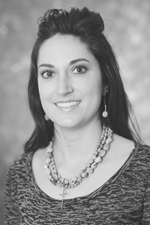
Nicole Lujan is the Home Economist/4-H agent for Sandoval County. She earned her B.S. in family and consumer sciences, clothing, textiles, and fashion, merchandising and her M.A. in agricultural and Extension education from New Mexico State University. Her Extension goals are to educate youth and adults to make positive changes in their everyday lives.
To find more resources for your business, home, or family, visit the College of Agricultural, Consumer and Environmental Sciences on the World Wide Web at pubs.nmsu.edu
Contents of publications may be freely reproduced for educational purposes. All other rights reserved. For permission to use publications for other purposes, contact pubs@nmsu.edu or the authors listed on the publication.
New Mexico State University is an equal opportunity/affirmative action employer and educator. NMSU and the U.S. Department of Agriculture cooperating.
June 2013, Las Cruces, NM


